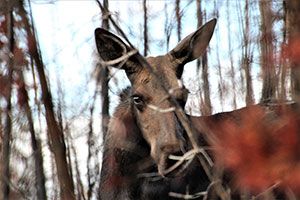UWs Biodiversity Institute Helps Coordinate Winter Moose Day Feb. 11
Published January 03, 2023

Those who like moose and want to try to spot one or maybe more are invited to search for the large mammals by snowshoe or skis.
For the ninth year running, community scientists will be able to help track moose populations in the mountains outside of Laramie for Winter Moose Day. Coordinated, in part, by the University of Wyoming’s Biodiversity Institute, the event is scheduled Saturday, Feb. 11, in the Vedauwoo/Happy Jack and Snowy Range Mountains areas. Registration will open Monday, Jan. 16, at www.wyobiodiversity.org. The deadline to register is Wednesday, Feb. 1. To register, go here.
Volunteers adopt survey routes and ski or snowshoe those routes to record all observations of moose or signs of moose. These can include tracks/hoofprints in snow, bed areas, scat droppings and browse on aspen and willows. To survey while moose are most active, participants are asked to get to their routes as early as dawn and to complete their surveys by noon.
These volunteer observations can be loaded into iNaturalist so the public can view right away where moose were seen. INaturalist is a joint initiative of the California Academy of Sciences and the National Geographic Society.
“The same number of routes -- 17 in Pole Mountain, 12 in the Snowies and two in Arlington -- is available each year. How many get surveyed depends on how many get adopted,” says Mason Lee, senior project coordinator for the Biodiversity Institute. “In previous years, routes were available on a first-come, first-served basis in an effort to get all routes surveyed. Beginning with Summer Moose Day last year, routes were available to more than one survey group. This change in our protocol allows us to collect more robust data for analysis.”
Lee adds the surveyors are “typically a mix” of some volunteers who participate each year as well as newcomers.
“We’re exploring the possibility of having some of our veteran moose-dayers collect more in-depth data this year, but the protocols are still being worked on for this,” she says.
The data gathered from Winter Moose Day are shared with biologists at UW. These biologists use the data collected by community scientists to further their understanding of the population densities of local moose, their reproductive rates, their winter ranges and how these variables change over time.
During the 2022 Winter Moose Day, 15 adult moose and four calves were observed, and many signs of moose -- scat, tracks, etc. -- were seen, Lee says. That was the greatest number of moose ever seen on one Winter Moose Day.
“Our best guess as to the number of moose we will see this year is the number we saw last year,” says Dave Christianson, an associate professor in the UW Department of Ecosystem Science and Management. “This is a ‘sciency’ answer and probably not a very satisfying answer, but one that is likely to be right more often than not. As scientists, we try to only let the data lead our assumptions.”
Lee says that Winter Moose Day is often marked by strong winds or snowfall, both of which can obscure fresh tracks and signs of moose. These conditions can result in few sightings of moose sign.
“Our new datasheets collect weather and visibility information so that this can be accounted for during data analysis,” Lee explains.
As of February 2022, the Wyoming Game and Fish Department estimated there were 3,105 moose in Wyoming, with moose populations stabilizing. The estimate is based on flight surveys conducted annually by the department.
“We should have an answer to the moose trend question by now after this many years of Moose Day,” Christianson says. “But, in addition to being a very difficult question to answer for any species, answering it with data collected by a haphazard collection is even harder. We are continually making improvements to the project and perfecting our approach.”
Both the winter and summer Moose Day events are geared toward increasing the public’s understanding of moose in the Laramie area and involving the public in asking and answering questions. These events are an extension of the original program, Moose Day, held by Nature Mapping Jackson Hole (NMJH) in Jackson each winter. NMJH is a citizen science program created by the Jackson Hole Wildlife Foundation.
Required training for new participants is scheduled Saturday, Feb. 4, from 10 a.m.-noon in the Berry Biodiversity Conservation Center. Training consists of a one-hour classroom session and a one-hour outside training component.
“Volunteers who are interested in collecting more in-depth data are encouraged to bring rangefinders and compasses to the training, if they have them,” Lee says. “We will have a few available for loan.”
The UW Biodiversity Institute fosters conservation of biodiversity through scientific discovery, creative dissemination, education and public engagement. In this setting, scientists, citizens, students and educators come together to share a wealth of perspectives on the study and appreciation of biodiversity -- from microbes to poetry and ecosystems to economics. Learn more at www.wyomingbiodiversity.org.

